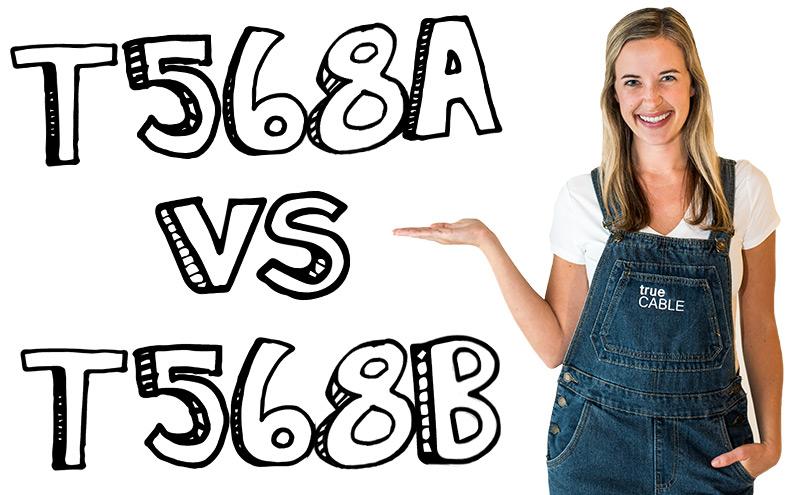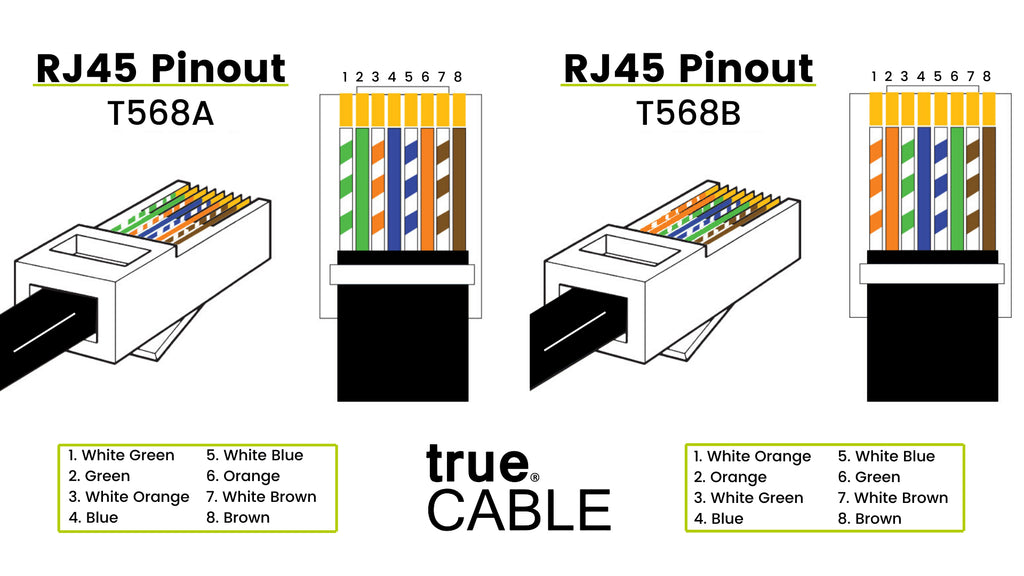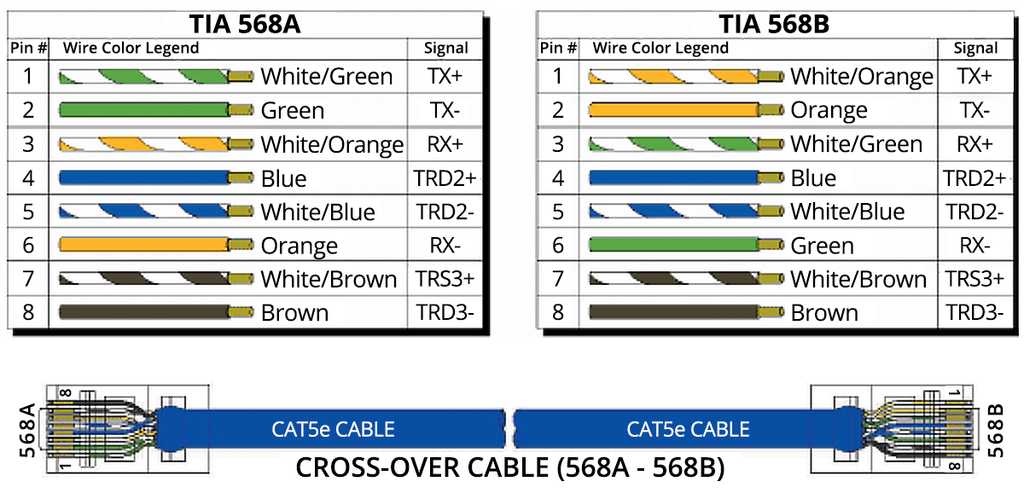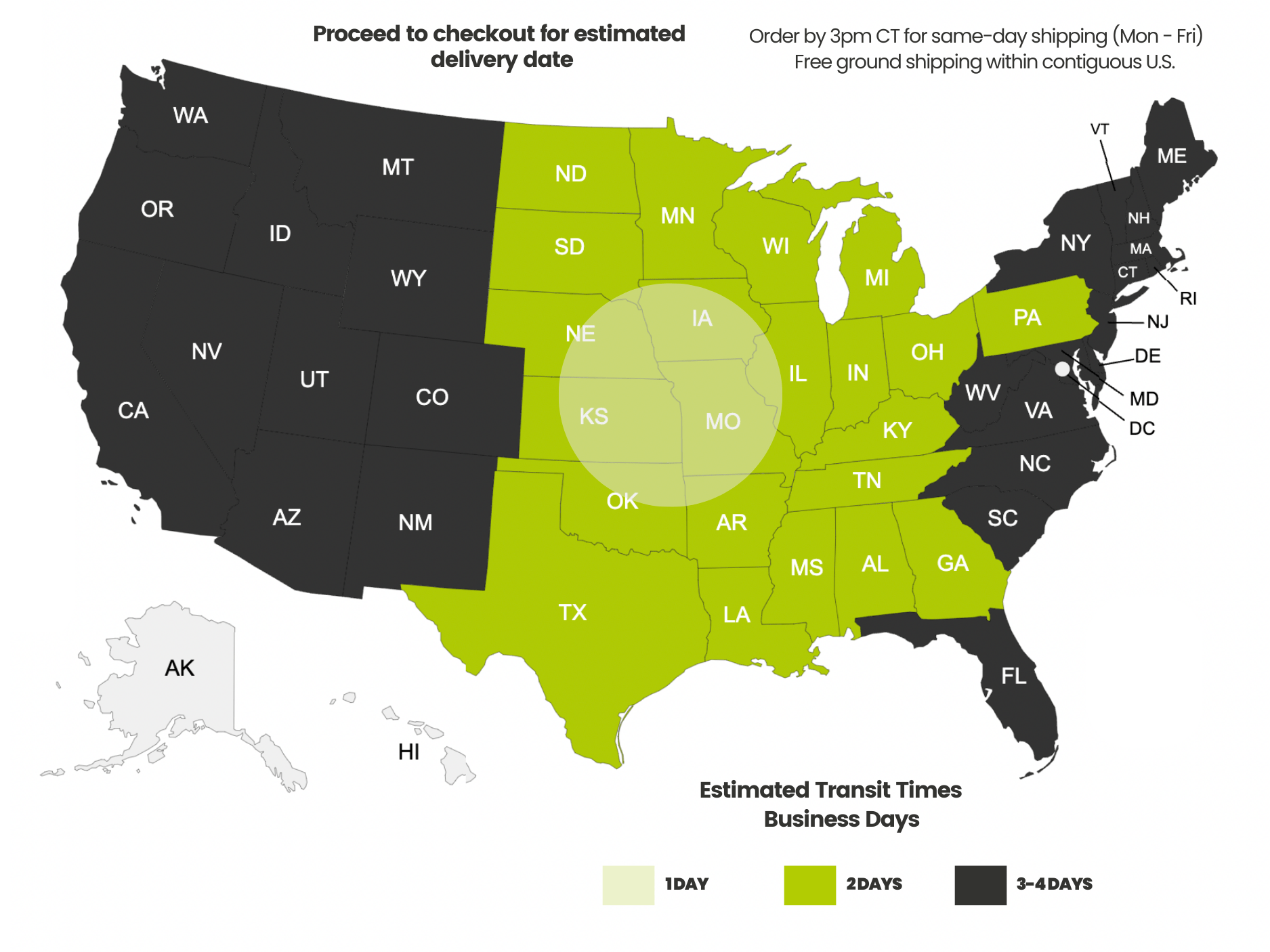Payment methods accepted

T568a vs T568b: Which To Use
Written by Don Schultz, trueCABLE Senior Technical Advisor, Fluke Networks Copper/Fiber CCTT, BICSI INST1, INSTC, INSTF Certified
Sometimes choosing between two technically different options, especially if you are a novice, is a tough decision. Which way do you go, and how do you find out? Well, you came to the right blog and video! When terminating the end(s) of Ethernet cable, you have to follow a certain color code scheme, T568A or T568B. This scheme is designed to help the installer get the conductor wires into the right order so that your cable will work properly. Get this part wrong, and you may end up with a non-working cable run. Whether it be an 8P8C RJ45 plug, keystone jack, or patch panel this holds true regardless of what kind of termination you are performing. And it does not matter if it is Cat5e, Cat6, Cat6A, or Cat8.
Confusion and Controversy
There are two schemes: T568A and T568B. From a practical standpoint, they perform and function identically in a modern data network. Just be sure you are using the same color scheme at both ends of your cable and you will stay out of trouble. I happen to prefer “B”. Why? I got lazy and did not want to memorize “A”. Fifteen years ago I might have given you a different answer, but things change.
T568A and T568B are the termination standards used by Internet backbone infrastructure, Internet providers and all the way down to homeowners or businesses. The only real difference between these two pin-to-pair assignments are the green and orange pairs. These two sets are swapped in the cable. Even though these are switched, they are still both effectively direct or “straight through” connections.

There is misinformation out there on this topic, fortunately most of it benign. This misinformation is not malicious, but sometimes people get used to doing something a certain way and then it becomes “gospel”. The culprit is often out of date information.
There are rare instances (like US government contractual requirements) when T568A may be specifically called out for use. Unless you have a customer dictating which one to use, then T568A versus T568B comes down to personal preference. If you don’t have any specific requirements to use one over the other, then simply pick one and stick with it. You don’t need to research any further.
The color code schemes are defined by the ANSI Accredited Telecommunications Industry Association (ANSI/TIA). In the absence of a stated customer requirement, the 2018 dated ANSI/TIA 568.2-D revision sets the commercial building standard for how to match twisted pair wires to a plug or socket. ANSI/TIA 570-D sets the residential standard. However, the standards have changed over time and this takes some by surprise, leading to confusion and misinformation. It also leads to lively debates!
As of 2018, ANSI/TIA still recommends T568A for residential installations for plug-in backward compatibility with old technology like fax machines or a plug-in base station for wireless phone handsets. If you are not using any such devices, or have no intention of plugging ancient RJ11 plugs into RJ45 wall jacks like you would a “phone jack”, then it comes back to personal preference again. In reality, just how many people are using this old equipment any longer? I personally switched over to cell phones in 2006 and have not looked back.
In the past, specifically with the old TIA/EIA 568-B-2 revision written and ratified around 2001, this recommendation was different for commercial and US government spaces. TIA recommended T568A at that time and further notated US government contracts require T568A. This was to maintain backward compatibility with older equipment like in the residential space (fax machines, etc.) As of the “D” revision, this is no longer the case and that recommendation and notation have been removed. The ANSI/TIA 568.2-D commercial standard is now mute on the subject unless you have a contractual or technical reason to go with one or the other. There is a warning in the commercial standard about making certain that both ends of the cable are terminated to the same scheme. In other words, pick one and stick with it.
So now that we have sorted out what the actual recommendations are, another common misconception is that one wiring scheme will perform better than the other. Let me put this to bed immediately: they are identical in regards to performance. I decided to conduct a test to prove this out.
Test conditions, components, and setup:
- 292 feet of trueCABLE Cat6A Riser U/UTP Ethernet cable
- Two trueCABLE Cat6 unshielded tool-less keystone jacks (these are component rated and impedance matching grade keystones)
- Fluke DSX-8000, in calibration, 6.5 B5 firmware, using the permanent link adapters
- A reference was set after a 10-minute warm-up of the Fluke DSX-8000
- The first test conducted was with the keystone jacks terminated to the T568B pattern
- The second test conducted was with the keystone jacks terminated to the T568A pattern
- The same ends of the cable were used at the remote and main units for both tests
- The same keystones used at the remote and main units were used on the same ends as well
- The ambient temperature was 71 degrees Fahrenheit
- The Cat6A cable was loosely coiled in three-foot coils, not actually installed
The results of the tests speak for themselves. It is a wash on performance.

T568A test

T568B test

Summarized results
Crossover Cable
So, if there is a “straight through” kind of cable run there must be a “not” straight through type (logically speaking), correct? Well, indeed there is. It is called a “cross over” cable where one end is terminated to T568A and the other is terminated to T568B. Where would one use that kind of thing?

Images credit: Industrial Ethernet Book
In most network applications, the standard straight through cabling method is required. For example, a computer plugged into a wall panel uses the standard cable configured with either T568A or T568B termination. This allows the computer to communicate with other devices on the local area network. Whether talking to a network printer or mail server, the data traverses the network because all the cabling has been put together using one of the above termination standards. The same is true for the cabling in the wall and the patch panel where they all terminate.
Now for other applications, we may need to connect a computer directly to another computer or a host-to-host connection. As an example, we need to copy data from one computer to another, but the two computers don’t have access to a switch for help with this process. These two computers need to use a crossover cable.
Please note that the use of cross-over cables is very rare in the modern age. There are some specialized applications for them, but you will likely never see it in the wild.
Summing this up, the whole T568A vs T568B thing has been a needless source of confusion and controversy for over two decades. Understanding how the standards evolved and your chances of encountering a situation where you will be forced into using one scheme or the other is not likely to happen in this day and age. Just pick one and go. With that, I say…
HAPPY NETWORKING!
trueCABLE presents the information on our website, including the “Cable Academy” blog and live chat support, as a service to our customers and other visitors to our website subject to our website terms and conditions. While the information on this website is about data networking and electrical issues, it is not professional advice and any reliance on such material is at your own risk.




































I've been wiring with B-style in residential thinking it was the one most companies used and the agreed-upon method. I didn't realize A was just as good and possibly more compatible with older analog devices.
I'd prefer to use the method most folks use. If they use A, I want to use A (not in this house; I'm gonna stick with B here). Whatever the industry chooses is what I should use, so it's easier to match.
It sounds like the only real reason for an A and a B method is for crossover cables which I do have, but those are CAT5. It's been years since I needed one because all switches and ports are Auto-MDIX now. I remember when my dad bought our first hub, and it had a dedicated uplink port which had a button-toggle for crossover or straight-through mode.
Hi, I wanted to share something that I found out 24 years ago, when running my first ethernet setup. It is a simple thing to forget and I have not seen it mentioned anywhere. When running your wires into the plug, do not bend the cable within 1 foot of the plug or you will have issues when crimping. If you have a need for a bend do it after the end is crimped. Second, make sure that even though you are "straight through" that your plugs are positioned the same direction. Which ever standard you use, the cable colors should match. This is more difficult if you are running a long jumper between locations and you cannot compare ends. With the tab away from you keep the same color in the 1 position. It made a difference when I walked two rooms down and accidently reversed the colors.

Hello,
i am absolutely new to the networking, but i have to put the wires to do the ethernet port.
I have a RJ11, GW 20 251, CAT-5 model and i dont find any model with video demostration on how to insert the colors of the wire.
I might have an old model or i dont know what,
but from **left *** side i have:
A: white-orange → orange → white-brown → brown
B: white-green → green → white-brown → brown
And from Right side i have:
A: white-blue → blue → white-green → green
B: white-blue → blue → white-orange → orange
I am watching the Ethernet Port from behind.
At the box of this GEWISS, i find written TYPE B.
Can anyone explain me where should i insert the cables? at what colors and what A or B?
Am i clear with what am i asking?
Hi just a quick question, i've just joined a company and my first job is to redo the patch panel. Although the panel is wired to the 'B' standard some of the ethernet cables used to connect the panel to the floor ports are wired to the 'A' standard (6 out of 32 to be precise) the 6 that are wired to 'A' were put in by my predecessor they just connect to standard PC's that also use the 'A' wiring to connect the PC to the floor port. So my question is – Does this matter? Should i replace these patch cables and re-wire the 6 ports on the patch panel with the 'B' standard to standardise the installation or just leave them as is.
Hello David! I understand the question and why you are confused about this. It is pretty common. The T568A and T568B pattern matters from discrete termination to discrete termination. If you use A on both sides, or B on both sides, the cable is considered “straight through”. What that means is your solid copper permanent link can be A to A and your patch cords all be B to B and you are good to. It is the wiring code used for each individual segment that matters.
As a software engineer, these are often situations that people don’t touch and leave as-is. Thing is, that causes more grief for the next guy who’ll inadvertently mess it up because he won’t have the same “lore” knowledge as you.
For only 6 runs? I’d get permission to spend a few hours re-terminating them all to match the B standard of the rest of the cables to avoid any confusion.
very nice explanation.. I just wanted to add an application that have used for cross over link from my computer to other computer was to share internet almost over 15 years ago…. it was a backup internet that I had on my computer when the main internet went off. I had to pull the cable from the modem/router that goes to switch and push it in my compute replacing the cable from the router…. I am not a network guy so I do not remember the exact things we used to do.. I believe you will have idea about it…
What is the pin out for Ethernet to serial?
Hello Clifford. The pinout for RJ45 (T568 A or B) to serial connections has no single answer. First, which T568 color code is the RJ45 wired to? Second, what kind of serial connector are we talking about (there are many variations). In addition to all of that, there may be equipment specific requirements on top of it all. We don’t have an answer for you, but recommend you seek assistance for this from the manufacturer of the equipment that has the serial connection on it.
I read through the info on the page here and I feel like I'm missing something. I am still new when it comes to dealing with networks outside of my personal use so I have not had a need to make cables. I have, however, done a good deal of electrical wiring. Functionally speaking, the color of the wires are meaningless. They are only colored to give us humans a reference point. The hot lead doesn't care if it's red or black as long as it is connected correctly. Is it not the same with this?
The devices you are connecting don't care that pin 3 is white/green instead of white orange as long as it is the same on both ends. From what I can tell, as long as you did it exactly the same on both ends, you could put the colors wherever you want and everything would function the same.
Not suggesting anyone do that! It's always best to follow industry standards!! Fastest way to make the next tech hate your guts is to do something completely random that only you understand. Doesn't matter if it works. I'm just exploring the question.
Hello, Anthony! Great question. You are correct in that electrons do not care about color. The color code is a human reference point. That said, it is NOT correct that you can simply match the colors at both ends and wire the way you want. The reason is that Ethernet has TWISTED pairs, and each pair is in electromagnetic balance. That is why there is a human reference point. If you were to match the colors at both ends and ignore the color code, you would likely have a out of balance cable and it would not work well or at all. We hope this helps!
Excellent! Thank you for the explanation.
I had the same thought as Anthony so I put together a 70’ CAT-6 cable that kept the twisted pairs together, it was easier. It delivered a mere 38.5 Mbps with 300 Mbps service and a Gb modem. Replaced the ends using the T-568B schema and it now delivers 330.2 Mbps of throughput.
I agree that there is no technical advantage of 568A over 568B, and no real difference when doing a cable run with a punch down product on either end. For me, the benefit of 568B is when having to make custom patch cables with RJ45 connectors on either end. All the CAT cable spools I have (and have ever come across) have orange diagonally across brown, and green diagonally across blue. Having orange and brown as the outer cable strands creates a more natural gap between them and makes it easier to spread the white-green and green strands apart to put the blue strands in between them. It can be done in the 568A configuration, but its more challenging to push the green strands and brown strands apart (since they are side by side) , put the blue strands between the white-orange and orange strands (again, side by side) and then squeeze them between the green and brown all the while trying to keep them flat and in line so they can be inserted into the RJ45 connector to be crimped. Use a CAT cable product that adds a spline to reduce crosstalk by separating the strands and 568B is the better option for making patch cords.
Hello John! I had not really thought of it from that perspective. Thanks for sharing your insight and experience.
This is pushing me to stick with the B wiring scheme. If the cables are designed this way, I’d rather use the one that makes it easier to connect everything. I’d also like to be the same as everyone in the industry, but it sounds like there’s no consensus.
Hello
I have a question;
Our contractor wants to use T568A. We useT568A from patch panel to data socket . Which type of ethernet cable am i chose from patch panel to switch? can i use T568B or have i continued to use T568A?
Hello! You can use patch cords that have been wired to either T568A or B, it does not matter. Both T568A and T568B are “straight through”.
"B" is the accepted standard so it is the one and only one I have ever made a cable for. This reminds me of the Beta verses VHS battle as well as the DVD R + & – battle and finally a claim for a winner yet it seems that the cable industry can't come to a final resting place. Please let's barry the hatchet, agree that "B" is the winner for some reason and move on just like VHS did and DVD R did. What I do know is that "B"is what I use and continue to use and as long as my one end matches my other end it doesn't really matter but it would be nice to settle on something for complicity sake. If you wire anything other than "B" I sure hope I don't come across your cables so I don't have to waste my time ripping them out and starting over from scratch.
Hello Perry. Per ANSI/TIA 568-2.D and 568.0-E there is no default preferred method. T568A and T568B are equally valid and equally performant. Unless the AHJ or contract has stated to use one or the other in an installation then it is up to the installer. Again, T568A and T568B are equivalent in every way except the orange and green pairs are swapped. The most important thing is to make sure you use the same pattern throughout your installation. It is not a matter of “burying the hatchet” as there should not have ever been a debate about this. The “debate” is artificial in nature and exists only in the mind of installers who have a “closely held personal belief” that one is somehow better than the other. If you want my personal opinion, I prefer B because that is what I happened to memorize and that pattern is easiest for me to remember but that is the ONLY reason I am using B. If you were to press me on why I am using B it is because I had to pick one over the other and only wanted to memorize just one. There is no justification for ripping out an installation because your preferred pattern was not used by the previous installer.
IIRC, T568A was the original standard internationally. T568B was included later because AT&T had been using that and asked it be included. Either one is a big improvement over the bad old days when we had to check how the termination hardware was wired internally and tell the cabling installer where to attach each colour.
As you note, they’re functionally equivalent, so pick one and stick with it.
If my ISP drop terminates with a keyjack that I can see is T568B, does that mean that all cabling from that point on should be T568B as well? Also, are all modern network ethernet devices (switches, routers, APs, etc) happy to accept either A or B?
Hello Jamie! Good question. I personally use T568B for any install I do, and have not come across a situation where T568A was required. As long as both ends of any discrete (termination to termination) cable run are wired using the same scheme, then the run is “straight through” and both schemes function identically. Your switches and other powered devices do not care whether which scheme you use as long as both ends of ANY ONE cable run are wired to the same scheme. In short, just pick one scheme and stick to it and you will never get yourself into trouble!
I may be wrong, but I believe Auto-MDIX is what enables you to put in a straight-through or crossover cable without worrying how either side was wired.
To my knowledge, this technology came about because switches and hubs in the past needed dedicated uplink ports for switch-to-switch connections, and those connections used crossover cables. Today, you can use straight-through for everything because Auto-MDIX handles automatically changing straight-through to crossover connections where necessary.
I remember as a kid plugging in a crossover cable and wondering why that device wouldn’t connect, but I also remember buying newer switches (in the early 2000s) that said “Auto-MDIX” as well.
I'm curious if you made up your own pinouts if the results be the same. Like are we wasting our time splitting the green wires or reversing the blue??
Hello Jim! Great question. If you decided to create your own pinout you would end up with a cable that is no longer in electromagnetic balance and thus a non-working cable. Long story short, don’t do it! Definitely stick with either T568A or T568B. Hope this helps. Please let us know if you have any further questions!
Is there a specific RJ45 pinout for T568C (cable cat6) or I need to choose between T568A and T568B? Thank you!
Hello Irineu! Great question! The correct choices are either T568A or T568B regardless of Category. There are no specific pinouts for any Category. We hope this helps. Please let us know if you have any further questions!